AREA SETUP
(Open thematic poster-Fabric) Print a variety of posters and use them to decorate the walls of your daycare. Hang a banner on the wall and ask children to create a mosaic by sticking pictures of people cut out of magazines on it.
Educa-theme-Fabric
(Open educa-theme-Fabric) Print and laminate the different elements representing the theme. Use them to present the theme to your group (and their parents) while decorating your daycare.
Educa-decorate-Fabric
(Open educa-decorate-Fabric) Print, laminate, and cut out the illustrations. Use them to decorate your walls and set the mood for the theme.
Garland-Fabric
Cut scraps of different types of fabric with a variety of textures and use the pieces to create a garland that can be hung near your daycare entrance or within your daycare.
Fabric wall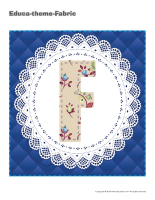
Hang a clothesline within your daycare, approximately 2 metres above the floor. Drape a blanket or bedsheet over it to represent a wall. Use safety pins to display children’s artwork on this fabric wall. Drape blankets and bedsheets over tables and chairs too. Encourage children to explore the different types of fabric.
Fabric box
To introduce your theme, set a box filled with square pieces of a variety of fabrics in one corner of your daycare. Select fabrics that offer a wide range of textures such as silk, felt, burlap, etc. Be sure to fill your box with different colors too. Let children manipulate the contents of the box.
A blanket on the ceiling
Hang your parachute from the ceiling, like a bed canopy. If you wish, hang a dark-coloured blanket from the ceiling and press glow-in-the-dark star-shaped stickers all over it (supervision required).
SPECIAL TOOL
This tool was created in response to a special request we received. (Open memos-Keep the daycare clean) Print, laminate and display this friendly reminder.
CIRCLE TIME
Animated discussion-Fabric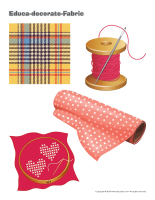
(Open word flashcards-Fabric) Print and laminate the pictures in the format you prefer. Use them to spark a conversation with your group. Ask children questions about fabric.
Identify (or name) the items
(Open giant word flashcards-Fabric) Print, laminate, and display the word flashcards on a wall in your circle time area or on a large piece of cardboard that you can move around. Children take turns identifying a word.
Poni discovers and presents-Fabric
(Open Poni discovers and presents-Fabric) Print and laminate the pictures. Use a Poni puppet (or another puppet children are familiar with) to present the pictures to your group.
Flipogram-Fabric
(Open picture game-Fabric) Print and laminate the pictures in the format you prefer. Use a hole-punch to make a hole in the upper right and left corner of each picture. Stack the pictures and insert a ring through each set of holes. The flipogram is easy to manipulate. Simply show children how they can lift a picture and flip it under the stack. Name each item with your group. Use the flipogram to encourage children to talk during circle time and to ask them questions about the theme.
PICTURE GAME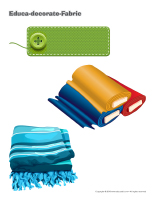
The pictures may be used as a memory game or to spark a conversation with the group. Use them to decorate the daycare or a specific thematic corner. (Open picture game-Fabric) Print, laminate, and store in a “Ziploc” bag or in your thematic bins.
Memory game-Fabric
(Open picture game-Fabric) Print the pictures twice and use them for a memory game.
ACTIVITY SHEETS AND WRITING ACTIVITIES
Activity sheets are provided for each theme. Print and follow instructions. (Open activity sheets-Fabric)
Ways to use activity sheets
Stick two markers or crayons end to end. Have children complete the first part of an activity sheet using one color before inching their fingers towards the other end to use the other color to complete it.
Different positions
Display activity sheets on walls, stick them on the floor, or secure them under tables. Children will have to vary their position to complete them.
Writing activities-F like fabric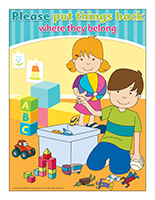
(Open writing activities-F like fabric) Print for each child or laminate for use with a dry-erase marker.
Educa-nuudles-Fabric
(Open educa-nuudles-Fabric) Print for each child. Have children color the sheet and use Magic Nuudles to give it a three-dimensional look. Variation: You don’t have Magic Nuudles? Have children fill the spaces designed for Magic Nuudles with bingo markers or stickers. To order Magic Nuudles.
Creating your own activity binder
Laminate several activity sheets and writing activities and arrange them in a binder along with dry-erase markers. Leave the binder in your writing area and let children complete the pages as they wish. At the end of the day, simply wipe off their work so the activity binder can be reused.
LANGUAGE ACTIVITIES
The flashcards may be used during circle time to spark a conversation with the group or in your reading and writing area. They may also be used to identify your thematic bins. (Open word flashcards-Fabric) (Open giant word flashcards-Fabric) fabric, color, sewing, clothing, thread, texture, seamstress, roll, curtain, scarf, polar fleece, silk
Let’s chat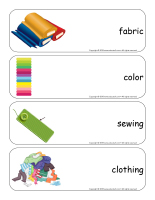
(Open word flashcards-Fabric) (Open giant word flashcards-Fabric) Print and laminate the word flashcards. Have each child pick a word and present it to the group (ex. seamstress). Ask them questions to see what they know about the theme.
Reinvented scrabble
(Open word flashcards-Fabric) (Open giant word flashcards-Fabric) Print many copies of the word flashcards and encourage children to use scrabble tiles to write the words. Manipulating the small tiles represents a great fine motor skill exercise. At the same time, children will notice which letters make up the different words.
Word clothesline
(Open word flashcards-Fabric) (Open giant word flashcards-Fabric) Print two copies of several word flashcards. Hang one copy of each word on an indoor clothesline with colourful clothespins. Arrange the copies in a pile on a table. Let children take turns picking a word and finding the matching word on the clothesline. When they find a match, they can place the flashcard on top of the one that was already hanging on the clothesline. Help younger children manipulate the clothespins if necessary.
Word race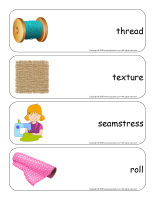
(Open word flashcards-Fabric) (Open giant word flashcards-Fabric) Print several word flashcards and hide them throughout your daycare or yard. Divide your group into two teams. When you give them the signal, children must search for the flashcards for a pre-determined period, for example three minutes. When the time is up, children must be able to “read” their flashcards to earn a point for their team. If they are unable to find the correct word, the other team can earn the point if they succeed.
Associating words and pictures
(Open word flashcards-Fabric) (Open giant word flashcards-Fabric) Print, laminate, and display the word flashcards on a wall close to your circle time area or on a large piece of cardboard you can move within your daycare. Children take turns identifying the words you name.
ROUTINES AND TRANSITIONS
My fabric path
Cut several shapes out of pieces of fabric and secure them on the floor to create a path within your daycare. The path can lead to areas children visit daily such as the bathroom, the cloakroom, etc. If you prefer, you may use the shapes to delimit various areas.
This is my spot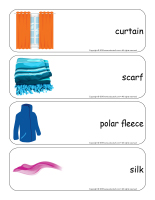
Use adhesive paper to stick pieces of fabric on your table. Set a piece of each type of fabric used in a bag. Children can take turns picking a piece of fabric out of the bag to determine where they shall sit at the table for the day. If you wish, you may also use the fabric pieces to determine naptime spots or children’s place in the task train.
PHYSICAL ACTIVITY AND MOTOR SKILLS
Fabric-covered floor
Cut several fabric squares the same size as your floor tiles (you must have enough to cover a fairly large area). Have children use the fabric squares to cover the tiles. Each square must touch another one, at the very least corner to corner. Use adhesive tape to hold the fabric squares in place. Use the fabric-covered floor for a game of musical squares or to create an interactive story (the blue squares can represent water children must hop over, the orange squares can represent fire, etc.).
Fabric
Cut triangles and squares out of different types of fabric and foam sheets. Let children use them to create a mosaic. They can take it apart and repeat this activity as often as they wish. You can provide large shapes that children can use to make a giant mosaic on the floor.
Fabric-covered blocks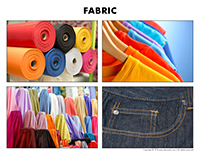
Provide a large quantity of blocks and fabric pieces in your construction area. Encourage children to cover the blocks or the structures they build with fabric to create three-dimensional projects.
Fabric race
Set shapes you have cut out of different colors of fabric on the floor. When you give the signal, children will have two minutes to collect as many objects as they can that are the color you call out. Have them set them on the fabric shape of the corresponding color.
Associating fabric and colors
Provide several bags in different colors (gift bags work well). Hide tiny pieces of fabric throughout your daycare. Give each child one bag and have them collect as many pieces of fabric that are the same color as their bag as they can. To increase the level of difficulty, use bags with two or more colors.
Where are the pieces of fabric?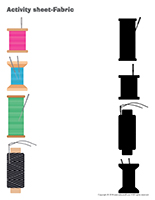
Hide a specific number of fabric pieces throughout your yard. Set a basket on the ground. Children can set the pieces they find in it. Invite them to search for the fabric pieces. Every time they find one, they must run to the basket and deposit it inside before going back to look for more. Continue until all the pieces have been found.
Bumpy blanket
Set a variety of soft objects on the ground (ex. sponge, small stuffed animals, cushions, etc.). Set a blanket on top of the objects and use heavy adhesive tape (sold in hardware stores) to secure the sides of the blanket on the floor. Let children crawl over the blanket.
Dancing scarves
Give children small scarves. To the sound of music, have fun dancing and waving the scarves around.
A clothing mountain
Set a large pile of clothing at one end of the daycare. Children must run to the pile, put a clothing item on, and come back to the starting line. This activity is a great way of helping children learn to dress themselves. If a child selects a clothing item that contains buttons or a zipper, encourage him to do the best he can to button or zip it.
MUSICAL AND RHYTHMIC ACTIVITIES
Musical fabric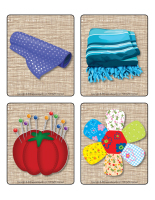
(Open picture game-fabric) Print and laminate the pictures. Stick them on the floor throughout your daycare. To the sound of music, children dance around the room. When the music stops, they must quickly find a picture to stand on. Variation: You can also choose to remove a picture at the end of each round. Children will therefore have to share the pictures if they don’t want to be eliminated.
Rhythmic fabric
In your yard, set several square pieces of fabric on the ground. Use a drum to represent different rhythms. With your group, associate each rhythm to a different color. For example, when you tap the drum very gently twice, children could stand on a blue piece of fabric. If you tap the drum once very loudly, children could have to move to a pink piece of fabric and so on.
OUTDOOR ACTIVITIES
The parachute
A parachute is a highly colourful accessory that children love to play with. Use it to explore a variety of games with your group throughout the theme.
Fabric colors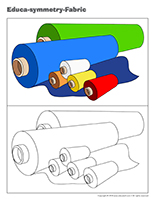
Children stand side by side on a line. As the game leader, you must give children instructions pertaining to the clothing items they are wearing. For example, you could ask all the children wearing blue shoes to hop or all the children wearing a red sweater to sit down. Variation: This activity can also be done indoors.
Parachute clothing toss
Empty your bin containing spare clothing items and a change of clothes for the children in your group (or just fabric scraps if you prefer) on your parachute. Bounce the parachute up and down with your group to send the items flying.
Colourful sock bin
Give two children one sock from each pair of socks that you have on hand for this activity. Two children may have a blue sock, two other children may have a red sock and so on. Give children instructions pertaining to the sock colors. For example, you may ask the children who have red socks to meow like a cat, the children who have yellow socks to hop like a frog, and the children who have a purple sock to slither like a snake.
COGNITIVE ACTIVITIES
Educa-symmetry-Fabric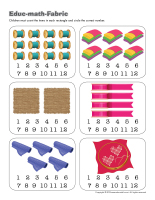
(Educa-symmetry-Fabric) Print. Children must color the picture on the bottom to make it look exactly like the picture on the top.
Educ-math-Fabric
(Open educ-math-Fabric) Print and laminate for durable, eco-friendly use. Children must count the items in each rectangle and circle the correct number.
The alarm clock
This activity is perfect for helping children acquire object permanence. Set an alarm clock or a timer under a blanket within your daycare and wait for it to ring. Let children lift the blanket to discover what is making the sound. With toddlers, you may set several blankets on the floor, with the alarm clock or timer under one of them. Let children search for the alarm clock.
Felt shapes and containers
Cut circles, squares, and triangles out of colourful felt. Make sure the shapes are big enough so they can safely be manipulated by young children. Let children explore them. Name the shapes. Set a series of plastic containers on the floor and have children fill them with the shapes. Older children will enjoy sorting them, placing a single shape in each container.
Object permanence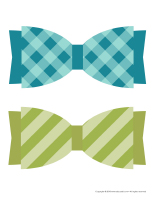
While children are watching, hide an object under a blanket. Wait a few minutes to see if the children in your group will lift the blanket to find it. Note that object permanence is rarely acquired before 9-10 months of age.
Contrasting textures
Using their sense of touch, children can discover how many different textures exist. Some are very soft whereas others are quite rough. Fill a bin with objects that have contrasting textures. Here are a few items that can be added to your bin: fur, velvet, brush, rug, sandpaper, textured ball, stuffed animal, etc. Recycle and reuse items you have on hand. Visit your local dollar store and touch a variety of items to find other things that may represent interesting additions to your bin.
MORAL AND SOCIAL ACTIVITIES
A blanket from home
For children, the scent of their home is reassuring. Select a day and invite parents to bring a blanket from their home to daycare. Let children play with their blanket. Add dolls and stuffed animals that children can wrap in the blankets and rock.
Photo booth-Fabric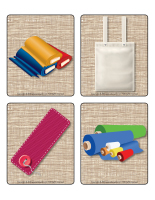
(Open photo booth-Fabric) Print the various accessories, cut them out, and glue a drinking straw behind each one. Purchase hats, scarves, glasses, etc. at your local dollar store. Create a fabric-filled décor using a large piece of cardboard and a curtain. Invite children to wrap themselves in pieces of fabric, pick the accessories they prefer and pose for you. You can take individual, group, or family photos. Print the pictures and display them on a wall for everyone to see.
Silly costumes
Have children sit in a circle on the floor. Set a box of accessories or a clothing bin in the centre of the circle. To the sound of music, children pass one clothing item or one accessory around the circle. When the music stops, the child who is holding the accessory or clothing item must put it on. Continue until the box or bin is empty.
Modified sweaters
This activity is great for encouraging children to build relationships with others. Collect several old sweaters so that you have one for you and one for each child in your group. Select sweaters that are one or two sizes too big. Sew large square pieces of fabric with different textures on the front and back of each sweater. Bright contrasting colors are best. Help children put the sweaters on and encourage them to touch the fabric squares.
EARLY SCIENCE/EXPLORATION/MANIPULATION
Sensory bin-Fabric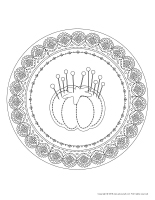
Throughout the week, leave a bin filled with different types of fabric in your daycare. Children will find many ways to play with the fabric as they discover new textures and explore colors.
Tongs and fabric
Collect different types of tongs in various sizes as well as a variety of types of fabric. Invite children to use the tongs to pick up the fabric and set the pieces in a container. This activity is ideal for developing fine motor skills.
How strong is the force of the wind?
Collect a variety of fabric scraps. Set them in front of a table fan or hairdryer one be one to see if they will fly away or stay put.
Fabric dyes
On white or very light cotton, test a variety of natural dyes (red cabbage, beets, powdered mustard diluted in water, blueberry juice, etc.) with your group.
ARTS & CRAFTS
Collective quilt
Painting on felt is both easy and fun. Its texture offers more resistance than paper and it therefore represents a great surface to explore painting with younger children. Use heavy adhesive tape (sold in hardware stores) to secure a square piece of felt on the table for each child. Let children paint on their piece of felt as they wish. When they are done, glue the pieces together on a wall to represent a quilt. If you prefer, you may sew them together too.
Adhesive paper and fabric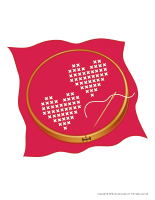
Hang a large piece of adhesive paper on the wall, with the sticky side towards you. You can use wide adhesive tape to hold it in place. Let children stick and remove fabric scraps as they please (supervision required).
Group project
Let children draw on a white bedsheet. When they are done, use the bedsheet as a tablecloth at lunch time or hang it from the ceiling in your reading corner like a bed canopy.
Mandalas-Fabric
(Open mandalas-Fabric) Print for each child. Encourage children to color the mandalas to help them relax.
Three-dimensional mosaic
Gather a variety of types of fabric that children can use to create a three-dimensional mosaic. Simply have them glue the pieces of fabric on a large piece of cardboard.
Tissue paper and glue
Cut several small tissue paper squares (different colors). Using Mod Podge or white glue diluted with water, let children stick the tissue paper pieces on a clear document protector. Encourage them to overlap the pieces somewhat. Let dry and display their work in a window.
Models-Fabric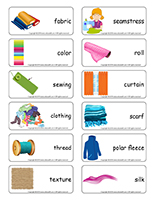
(Open models-Fabric) Print the models and use them for your activities and projects throughout the theme.
Fabric bin
Ask around to collect as many fabric scraps as you can get your hands on: fur, felt, burlap, silk, velvet, etc. Old clothing items can be cut to add to your fabric bin. Let children manipulate the pieces of fabric and use them for a variety of crafts.
Fur-covered picture
Print the picture of an animal that has fur, a rabbit for example. Cut a small piece of fake fur and stick it on the animal. Display the picture in your naptime area. Children will enjoy feeling the fur before lying down for their nap. If you prefer, display the picture near your daycare entrance. Children will immediately be attracted to it when they arrive.
Fabric mosaic
Use several different types of fabric to create a colourful mural with your group.
Sock snake
Use an old sock to represent a snake. Simply stuff it with newspaper and sew the open end. Add wiggly eyes, a felt tongue, spots or stripes, etc. If you wish, use hot glue to add tiny bells to make a rattlesnake sock. Have fun finding a name for your snake!
My sweater
Cut holes out of a brown paper grocery bag for each child (one for the head and two for the arms). Let children decorate their paper sweater with scraps of fabric and ribbon.
COLORING PAGES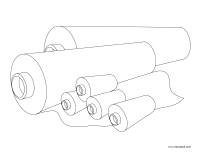
(Open coloring pages theme-Fabric) Print for each child.
DIFFERENT WAYS TO USE THE COLORING PAGES
Identical coloring pages-Fabric
Print the same coloring page for each child and an additional copy for your model. Color only certain parts of your picture. Present the model to your group and ask them to color their picture to make it look exactly like yours.
Coloring binder-Fabric
Print and laminate several coloring pages and arrange them in a binder with a few dry-erase markers. Leave everything on a table for children to explore.
Musical drawing-Fabric
Play musical drawing with your group. Give each child a coloring page. Have children sit around a table. When the music starts, they must pass the coloring pages around the table. Every time the music stops, they must color the picture in front of them until the music starts again.
Homemade puzzles-Fabric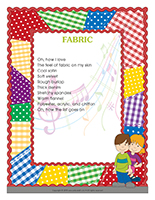
Give each child a picture to color. When they are done, cut each picture into pieces to create unique puzzles.
SONGS & RHYMES
By: Patricia Morrison
(Open songs & rhymes-Fabric)
Fabric
Oh, how I love
The feel of fabric on my skin
Cool satin
Soft velvet
Rough burlap
Thick denim
Stretchy spandex
Warm flannel
Polyester, acrylic, and chiffon
Oh, how the list goes on
Have fun
The educatall club
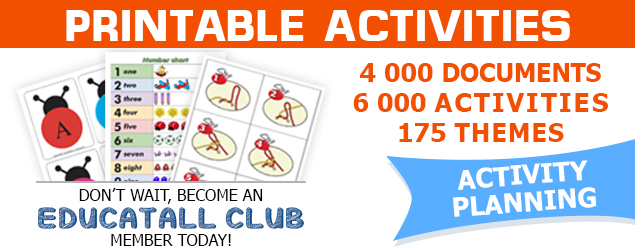
 Home
Home Theme activities
Theme activities
 Babies and toddlers
Babies and toddlers
 Arts and crafts
Arts and crafts
 Science
Science
 Creative recipes
Creative recipes
 Tips and tricks
Tips and tricks
 Special needs
Special needs
 Extra activities
Extra activities
 Educ-TV
Educ-TV
 Newsletter
Newsletter  Online store
Online store Educatall club
Educatall club

